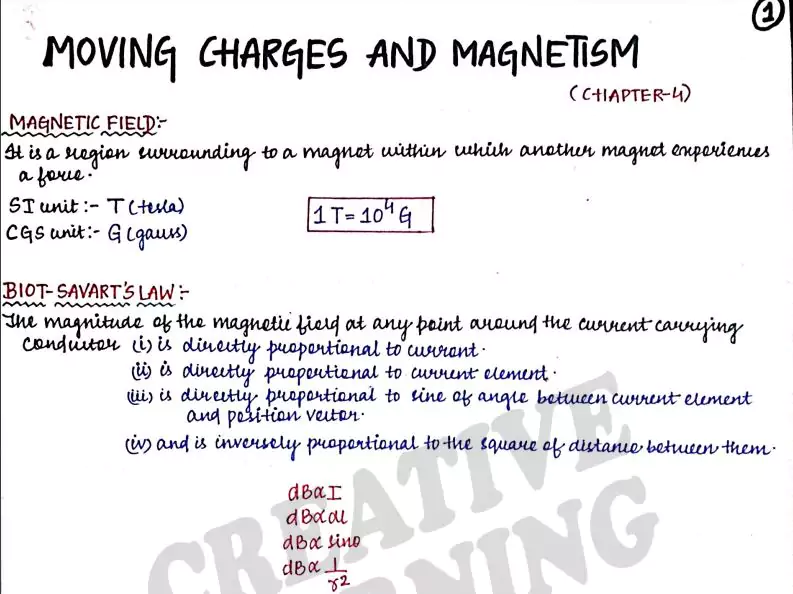‘Physics Notes For Class 12 Chapter 4 Moving Charges ‘ PDF Quick download link is given at the bottom of this article. You can see the PDF demo, size of the PDF, page numbers, and direct download Free PDF of ‘Moving Charges And Magnetism Class 12 Notes Physics’ using the download button.
Moving Charges And Magnetism Class 12 Notes Chapter 4 PDF Free Download

HELICAL MOTION OF CHARGED PARTICLES AND AURORA BOREALIS
In polar regions like Alaska and Northern Canada, a splendid display of colors is seen in the sky.
The appearance of dancing green and pink lights is fascinating and equally puzzling.
An explanation of this natural phenomenon is now found in physics, in terms of what we have studied here.
Consider a charged particle of mass m and charge q, entering a region of magnetic field B with an initial velocity of v. Let this velocity have a component v p parallel to the magnetic field and a component normal to it.
There is no force on a charged particle in the direction of the field. Hence the particle continues to travel with the velocity vp parallel to the field.
The normal component vn of the particle results in a Lorentz force (vn × B) which is perpendicular to both vn and B. As seen in Section 4.3.1 the particle thus has a tendency to perform a circular motion in a plane perpendicular to the magnetic field.
When this is coupled with the velocity parallel to the field, the resulting trajectory will be a helix along the magnetic field line, as shown in Figure (a) here.
Even if the field line bends, the helically moving particle is trapped and guided to move around the field line.
Since the Lorentz force is normal to the velocity of each point, the field does no work on the particle and the magnitude of velocity remains the same.
During a solar flare, a large number of electrons and protons are ejected from the sun.
Some of them get trapped in the earth’s magnetic field and move in helical paths along the field lines. The field lines come closer to each other near the magnetic poles; see Figure (b).
Hence the density of charges increases near the poles. These particles collide with atoms and molecules in the atmosphere.
Excited oxygen atoms emit green light and excited nitrogen atoms emit pink light.
This phenomenon is called the Aurora Borealis in physics.
Cyclotron
The cyclotron is a machine to accelerates charged particles or ions to high energies. It was invented by E.O. Lawrence and M.S. Livingston in 1934 to investigate nuclear structure.
The cyclotron uses both electric and magnetic fields in combination to increase the energy of charged particles.
As the fields are perpendicular to each other they are called crossed fields.
The cyclotron uses the fact that the frequency of revolution of the charged particle in a magnetic field is independent of its energy.
The particles move most of the time inside two semicircular disc-like metal containers, D1 and D2, which are called dees as they look like the letter D.
Figure 4.8 shows a schematic view of the cyclotron. Inside the metal boxes, the particle is shielded and is not acted on by the electric field.
The magnetic field, however, acts on the particle and makes it go around in a circular path inside a dee. Every time the particle moves from one dee to another it is acted upon by the electric field.
The sign of the electric field is changed alternately in tune with the circular motion of the particle. This ensures that the particle is always accelerated by the electric field.
India has been an early entrant in the area of accelerator-based research.
The vision of Dr. Meghnath Saha created a 37″ Cyclotron in the Saha Institute of Nuclear Physics in Kolkata in 1953.
This was soon followed by a series of Cockroft-Walton type accelerators established in Tata Institute of Fundamental Research (TIFR), Mumbai, Aligarh Muslim University (AMU), Aligarh, Bose Institute, Kolkata, and Andhra University, Waltair.
Besides these ion accelerators, the Department of Atomic Energy (DAE) has developed many electron accelerators.
A 2 GeV Synchrotron Radiation Source is being built in Raja Ramanna Centre for Advanced Technologies, Indore.
| Author | – |
| Language | English |
| No. of Pages | 19 |
| PDF Size | 8 MB |
| Category | Physics |
| Source/Credits | drive.google.com |
Moving Charges And Magnetism Class 12 Notes Chapter 4 PDF Free Download
